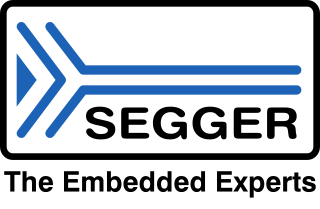
An embedded system is a specialized computer system—a combination of a computer processor, computer memory, and input/output peripheral devices—that has a dedicated function within a larger mechanical or electronic system. It is embedded as part of a complete device often including electrical or electronic hardware and mechanical parts. Because an embedded system typically controls physical operations of the machine that it is embedded within, it often has real-time computing constraints. Embedded systems control many devices in common use. In 2009, it was estimated that ninety-eight percent of all microprocessors manufactured were used in embedded systems.

A debugger or debugging tool is a computer program used to test and debug other programs. The main use of a debugger is to run the target program under controlled conditions that permit the programmer to track its execution and monitor changes in computer resources that may indicate malfunctioning code. Typical debugging facilities include the ability to run or halt the target program at specific points, display the contents of memory, CPU registers or storage devices, and modify memory or register contents in order to enter selected test data that might be a cause of faulty program execution.

AVR is a family of microcontrollers developed since 1996 by Atmel, acquired by Microchip Technology in 2016. These are modified Harvard architecture 8-bit RISC single-chip microcontrollers. AVR was one of the first microcontroller families to use on-chip flash memory for program storage, as opposed to one-time programmable ROM, EPROM, or EEPROM used by other microcontrollers at the time.

PIC is a family of microcontrollers made by Microchip Technology, derived from the PIC1640 originally developed by General Instrument's Microelectronics Division. The name PIC initially referred to Peripheral Interface Controller, and is currently expanded as Programmable Intelligent Computer. The first parts of the family were available in 1976; by 2013 the company had shipped more than twelve billion individual parts, used in a wide variety of embedded systems.

The MSP430 is a mixed-signal microcontroller family from Texas Instruments, first introduced on 14 February 1992. Built around a 16-bit CPU, the MSP430 was designed for low power consumption, embedded applications and low cost.
JTAG is an industry standard for verifying designs of and testing printed circuit boards after manufacture.
Nios II is a 32-bit embedded processor architecture designed specifically for the Altera family of field-programmable gate array (FPGA) integrated circuits. Nios II incorporates many enhancements over the original Nios architecture, making it more suitable for a wider range of embedded computing applications, from digital signal processing (DSP) to system-control.

In-system programming (ISP), or also called in-circuit serial programming (ICSP), is the ability of some programmable logic devices, microcontrollers, chipsets and other embedded devices to be programmed while installed in a complete system, rather than requiring the chip to be programmed prior to installing it into the system. It also allows firmware updates to be delivered to the on-chip memory of microcontrollers and related processors without requiring specialist programming circuitry on the circuit board, and simplifies design work.

V850 is a 32-bit RISC CPU architecture produced by Renesas Electronics for embedded microcontrollers. It was designed by NEC as a replacement for their earlier NEC V60 family, and was introduced shortly before NEC sold their designs to Renesas in the early 1990s. It has continued to be developed by Renesas as of 2018.

In integrated circuit design, hardware emulation is the process of imitating the behavior of one or more pieces of hardware with another piece of hardware, typically a special purpose emulation system. The emulation model is usually based on a hardware description language source code, which is compiled into the format used by emulation system. The goal is normally debugging and functional verification of the system being designed. Often an emulator is fast enough to be plugged into a working target system in place of a yet-to-be-built chip, so the whole system can be debugged with live data. This is a specific case of in-circuit emulation.
Background debug mode (BDM) interface is an electronic interface that allows debugging of embedded systems. Specifically, it provides in-circuit debugging functionality in microcontrollers. It requires a single wire and specialized electronics in the system being debugged. It appears in many Freescale Semiconductor products. Background commands are categorized into two types: Non-intrusive commands and Active background commands. Non-intrusive commands can be issued while the user program is running, which include memory access commands.
Nexus or IEEE-ISTO 5001-2003 is a standard debugging interface for embedded systems.

Segger Microcontroller, founded in 1992, is a private company involved in the embedded systems industry. It provides products used to develop and manufacture four categories of embedded systems: real-time operating systems (RTOS) and software libraries (middleware), debugging and trace probes, programming tools, and in-system programmers. The company is headquartered in Monheim am Rhein, Germany, with remote offices in Gardner, Massachusetts; Milpitas, California; and Shanghai, China.

PICkit is a family of programmers for PIC microcontrollers made by Microchip Technology. They are used to program and debug microcontrollers, as well as program EEPROM. Some models may also feature logic analyzers and serial communications (UART) tools.

The HP 64000 Logic Development System, introduced 17 September 1979, is a tool for developing hardware and software for products based on commercial microprocessors from a variety of manufacturers. The systems assisted software development with assemblers and compilers for Pascal and C, provided hardware for in-circuit emulation of processors and memory, had debugging tools including logic analysis hardware, and a programmable read-only memory (PROM) chip programmer. A wide variety of optional cards and software were available tailored to particular microprocessors. When introduced the HP 64000 had two distinguishing characteristics. First, unlike most microprocessor development systems of the day, such as the Intel Intellec and Motorola EXORciser, it was not dedicated to a particular manufacturer's microprocessors, and second, it was designed such that up to six workstations could be connected via the HP-IB (IEEE-488) instrumentation bus to a common hard drive and printer to form a tightly integrated network.
Each time Intel launched a new microprocessor, they simultaneously provided a system development kit (SDK) allowing engineers, university students, and others to familiarise themselves with the new processor's concepts and features. The SDK single-board computers allowed the user to enter object code from a keyboard or upload it through a communication port, and then test run the code. The SDK boards provided a system monitor ROM to operate the keyboard and other interfaces. Kits varied in their specific features but generally offered optional memory and interface configurations, a serial terminal link, audio cassette storage, and EPROM program memory. Intel's Intellec development system could download code to the SDK boards.
A debug port is a diagnostic interface included in an electronic system or integrated circuit to aid design, fabrication, development, bootstrapping, configuration, debugging, and post-sale in-system programming. In general terms, a debug port is not necessary for end-use function and is often hidden or disabled in finished products.

LPC is a family of 32-bit microcontroller integrated circuits by NXP Semiconductors. The LPC chips are grouped into related series that are based around the same 32-bit ARM processor core, such as the Cortex-M4F, Cortex-M3, Cortex-M0+, or Cortex-M0. Internally, each microcontroller consists of the processor core, static RAM memory, flash memory, debugging interface, and various peripherals. The earliest LPC series were based on the Intel 8-bit 80C51 core. As of February 2011, NXP had shipped over one billion ARM processor-based chips.
RL78 Family is a 16-bit CPU core for embedded microcontrollers of Renesas Electronics introduced in 2010.
MIPI Alliance Debug Architecture provides a standardized infrastructure for debugging deeply embedded systems in the mobile and mobile-influenced space. The MIPI Alliance MIPI Debug Working Group has released a portfolio of specifications; their objective is to provide standard debug protocols and standard interfaces from a system on a chip (SoC) to the debug tool. The whitepaper Architecture Overview for Debug summarizes all the efforts. In recent years, the group focused on specifying protocols that improve the visibility of the internal operations of deeply embedded systems, standardizing debug solutions via the functional interfaces of form factor devices, and specifying the use of I3C as debugging bus.











